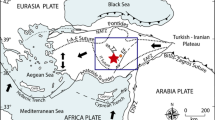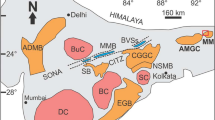Abstract
The 14.1 Ma composite welded ignimbrite P1 (45 km3 DRE) on Gran Canaria is compositionally zoned from a felsic lower part to a basaltic top. It is composed of four component magmas mixed in vertically varying proportions: (1) Na-rhyolite (10 km3) zoned from crystal-poor to highly phyric; (2) a continuously zoned, evolved trachyte to sodic trachyandesite magma group (6 km3); (3) a minor fraction of Na-poor trachyandesite (<1 km3); and (4) nearly aphyric basalt (26 km3) zoned from 4.3 to 5.2 wt% MgO. We distinguish three sites and phases of mixing: (a) Mutual mineral inclusions show that mixing between trachytic and rhyolitic magmas occurred during early stages of their intratelluric crystallization, providing evidence for long-term residence in a common reservoir prior to eruption. This first phase of mixing was retarded by increasing viscosity of the rhyolite magma upon massive anorthoclase precipitation and accumulation. (b) All component magmas probably erupted through a ring-fissure from a common upper-crustal reservoir into which the basalt intruded during eruption. The second phase of mixing occurred during simultaneous withdrawal of magmas from the chamber and ascent through the conduit. The overall withdrawal and mixing pattern evolved in response to pre-eruptive chamber zonation and density and viscosity relationships among the magmas. Minor sectorial variations around the caldera reflect both varying configurations at the conduit entrance and unsteady discharge. (c) During each eruptive pulse, fragmentation and particulate transport in the vent and as pyroclastic flows caused additional mixing by reducing the length scale of heterogeneities. Based on considerations of magma density changes during crystallization, magma temperature constraints, and the pattern of withdrawal during eruption, we propose that eruption tapped the P1 magma chamber during a transient state of concentric zonation, which had resulted from destruction of a formerly layered zonation in order to maintain gravitational equilibrium. Our model of magma chamber zonation at the time of eruption envisages a basal high-density Na-poor trachyandesite layer that was overlain by a central mass of highly phyric rhyolite magma mantled by a sheath of vertically zoned trachyte-trachyandesite magma along the chamber walls. A conventional model of vertically stacked horizontal layers cannot account for the deduced density relationships nor for the withdrawal pattern.
Similar content being viewed by others
References
Anderson AT (1976) Magma mixing: petrological process and volcanological tool. J Volcanol Geotherm Res 1:3–33
Bacon CR, Metz J (1984) Magmatic inclusions in rhyolites, contaminated basalts, and compositional zonation beneath the Coso volcanic field, California. Contrib Mineral Petrol 85:346–365
Blake S (1981) Eruptions from zoned magma chambers. J geol Soc London 138:281–287
Blake S, Ivey GN (1986) Magma-mixing and the dynamics of withdrawal from stratified reservoirs. J Volcanol Geotherm Res 27:153–178
Boden DR (1989) Evidence for step-function zoning of magma and eruptive dynamics, Toquima Caldera Complex, Nevada. J Volcanol Geotherm Res 37:39–57
Bottinga Y, Richet P, Weill DF (1983) Calculation of the density and thermal expansion coefficient of silicate liquids. Bull Mineral 106:129–138
Bowen NL (1928) The evolution of the igneous rocks. Princeton University Press, Princeton, NJ, USA, pp 334
Bunsen (1851) Über die Prozesse der vulkanischen Gesteinsbildungen Islands. Annal Phys Chem 83:197–272
Campbell IH, Turner JS (1986) The influence of viscosity on fountains in magma chambers. J Petrol 27:1–30
Carslaw HS, Jaeger JC (1959) Conduction of heat in solids. Oxford University Press, Oxford, UK, pp 510
Eichelberger JC (1980) Vesiculation of mafic magma during replenishment of silicic magma reservoirs. Nature 288:446–450
Freundt A (1989) Composite flow P1 on Gran Canaria: evolution of a rhyolite-trachyte-basalt magma system culminating in mixed-magma eruption and formation of silicic and basaltic welded ignimbrite. PhD-thesis, Ruhr-Universität Bochum, FRG, pp 444
Freundt A, Schmincke HU (1993a) Emplacement and welding of a basaltic and silicic ignimbrite, composite flow P1, Gran Canaria. Bull Volcanol (in prep)
Freundt A, Schmincke HU (1993b) Magmatic evolution at the turn from basaltic to silicic shield volcanism on Miocene Gran Canaria, Canary Islands: I. Petrography, mineral chemistry, and temperature and depth of magma chambers. J Petrol (submitted)
Freundt A, Schmincke HU (1993c) Magmatic evolution at the turn from basaltic to silicic shield volcanism on Miocene Gran Canaria, Canary Islands: II. Geochemistry and petrogenesis. J Petrol (submitted)
Freundt A, Tait SR (1986) The entrainment of high-viscosity magma into low-viscosity magma in eruption conduits. Bull Volcanol 48:325–339
Fridrich CJ, Mahood GA (1987) Compositional layers in the zoned magma chamber of the Grizzly Peak Tuff. Geology 15:299–303
Frost TP, Lindsay JR (1988) MAGMIX: A BASIC program to calculate viscosities of interacting magmas of differing composition, temperature, and water content. Comput Geosc 14:213–228
Hildreth W (1981) Gradients in silicic magma chambers: implications for lithospheric magmatism. J Geophys Res 86:10153–10192
Hildreth W (1983) The compositionally zoned eruption of 1912 in the Valley of Ten Thousand Smokes, Katmai National Park, Alaska. J Volcanol Geotherm Res 18:1–56
Huppert HE, Sparks RSJ, Turner JS (1982) Effects of volatiles on mixing in calc-alkaline magma systems. Nature 297:554–557
Jørgensen KA (1980) The Thorsmörk ignimbrite: an unusual comenditic pyroclastic flow in southern Iceland. J Volcanol Geotherm Res 8:7–22
Koyaguchi T (1985) Magma mixing in a conduit. J Volcanol Geotherm Res 25:365–369
Le Maitre RW, Bateman P, Dudek A, Keller J, Lameyre J, Le Bas MJ, Sabine PA, Schmid R, Sørensen H, Streckeisen A, Woolley AR, Zanettin B (1989) A classification of igneous rocks and glossary of terms. Recommendation of the IUGS subcommission on the systematics of igneous rocks. Blackwell Scientific Publ, Oxford, UK, pp 193
Lipman PW, Christiansen RL, O'Connor JT (1966) A compositionally zoned ash-flow sheet in southern Nevada. US Geol Surv Prof Pap 524-F:1–47
Macdonald GA, Katsura T (1965) Eruption of Lassen Peak, Cascade Range, California, in 1915: example of mixed magmas. Geol Soc Am Bull 76:475–482
Marsh BD (1981) On the crystallinity, probability of occurrence, and rheology of lava and magma. Contrib Mineral Petrol 78:85–98
Marsh BD (1988) Crystal capture, sorting, and retention in convecting magma. Geol Soc Am Bull 100:1720–1737
McBirney AR (1980) Mixing and unmixing of magmas. J Volcanol Geotherm Res 7:357–371
Oldenburg CM, Spera FJ, Yuen DA, Sewell G (1989) Dynamic mixing in magma bodies: theory, simulations, and implications. J Geophys Res 94:9215–9236
Ross CS, Smith RL (1961) Ash-flow tuffs: their origin, geologic relations and identification. US Geol Surv Prof Pap 366:1–81
Schmincke HU (1967) Cone sheet swarm, resurgence of Tejeda caldera, and the early geologic history of Gran Canaria. Bull Volcanol 31:153–162
Schmincke HU (1968) Faulting versus erosion and the reconstruction of the Mid-Miocene shield volcano of Gran Canaria. Geol Mittlg 8:23–50
Schmincke HU (1969a) Petrologie der phonolithischen bis rhyolithischen Vulkanite auf Gran Canaria, Kanarische Inseln. Habilitation thesis, Ruprecht-Karl Universität, Heidelberg, FRG, pp 151
Schmincke HU (1969b) Ignimbrite sequence on Gran Canaria. Bull Volcanol 33:1199–1219
Schmincke HU (1982) Volcanic and chemical evolution of the Canary Islands. In: von Rad U, Hinz K, Sarnthein M, Seibold E (eds) Geology of the northwest African continental margin. Springer, Berlin Heidelberg New York, pp 273–306
Schmincke HU (1990) Geological field guide Gran Canaria. With contributions from Freundt A, Ferriz H, Kobberger G and Leat P. Excursion 7BI International Volcanological Congress, Mainz, FRG, Pluto Press, Witten, pp 210
Schmincke HU, Swanson DA (1966) Eine alte Caldera auf Gran Canaria. N Jb Geol Paläont Mh 5:260–269
Schuraytz BC, Vogel TA, Younker LW (1989) Evidence for dynamic withdrawal from a layered magma body: the Topopah Spring Tuff, southwestern Nevada. J Geophys Res 94:5925–5942
Shaw HR (1972) Viscosities of magmatic silicate liquids: an empirical method of prediction. Am J Sci 272:870–893
Sigurdsson H, Sparks RSJ (1981) Petrology of rhyolitic and mixed magma ejecta from the 1875 eruption of Askja, Iceland. J Petrol 22:41–84
Smith RL (1979) Ash-flow magmatism. In: Chapin CE, Elston WE (eds) Ash-flow tuffs, Geol Soc Am Spec Pap 180:5–27
Smith RL, Bailey RA (1966) The Bandelier Tuff: a study of ash-flow eruption cycles from zoned magma chambers. Bull Volcanol 29:83–104
Sparks RSJ, Marshall LA (1986) Thermal and mechanical constraints on mixing between mafic and silicic magmas. In: Kushiro I (ed) M Sakuyama, H Fukuyama memorial volume. J Volcanol Geotherm Res 29:99–124
Thompson RA, Dungan MA (1985) The petrology and geochemistry of the Handkerchief Mesa mixed magma complex, San Juan Mountains, Colorado. J Volcanol Geotherm Res 26:251–274
Turner JS (1980) A fluid-dynamic model of differentiation and layering in magma chambers. Nature 285:213–215
Vogel TA, Wilbrand JT (1978) Coexisting acidic and basic melts: geochemistry of a composite dike. J Geol 86:353–371
Whitney JA (1988) The origin of granite: the role and source of water in the evolution of granitic magmas. Geol Soc Am Bull 100:1886–1897
Wiebe RA (1987) Evidence for stratification of basic, silicic, and hybrid magmas in the Newark Island layered intrusion, Nain, Labrador. Geology 15:349–352
Wilson L, Head III JW (1981) Ascent and eruption of basaltic magma on the Earth and Moon. J Geophys Res 86:2971–3001
Wörner G, Schmincke HU (1984) Mineralogy and geochemical evolution of the Laacher See magma chamber. J Petrol 25:805–835
Wolff JA, Wörner G, Blake S (1990) Gradients in physical parameters in zoned felsic magma bodies: implications for evolution and eruptive withdrawal. J Volcanol Geotherm Res 43:37–55
Wright TL (1971) Chemistry of Kilauea and Mauna Loa lava in space and time. US Geol Survey Prof Pap 735:1–40
Wright TL, Fiske RS (1971) Origin of differentiated hybrid lavas of Kilauea volcano, Hawaii. J Petrol 12:1–65
Author information
Authors and Affiliations
Rights and permissions
About this article
Cite this article
Freundt, A., Schmincke, HU. Mixing of rhyolite, trachyte and basalt magma erupted from a vertically and laterally zoned reservoir, composite flow P1, Gran Canaria. Contrib Mineral Petrol 112, 1–19 (1992). https://doi.org/10.1007/BF00310952
Received:
Accepted:
Issue Date:
DOI: https://doi.org/10.1007/BF00310952




